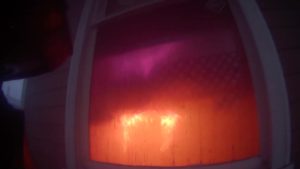A good interior helmet camera example of gas flame moving through the inside of a residential space. Often times even though houses can appear heavily involved from outside, the broken-up nature of many residential floor plans lends itself to there being many spaces, even in close proximity to the fire, area which will be in good shape and where we can make a huge difference with a confinement mindset.
Both videos are the same fire. I love the open back door off of the mudroom here and how you can see that as soon as the nozzle is opened, the exhaust starts to turn back around into an intake, increasing when the fire stream pops the window of the extension room and increases the ventilation profile.
A few years ago in our area when we started to really look at our fire attacks, we would get comments or questions like “I’ve never needed to flow while moving so far in my career, why should I do it now?”. While you could make the argument that there are more than likely numerous fires in that person’s career that they would have been able to confine and extinguish instead of getting pushed out of the building or posting up in a spot while they lose control of the fire, this would most likely result in triggering their ego to the point that you cannot have a conversation with them. We had better luck with showing video like this, then pointing to adjacent rooms and asking about what conditions for victims and search crews would be like in them. At the end of the day, it comes down to an old adage that one of my mentors and a senior retired officer from my department told us years ago: “Fight fire like you’re naked”. The gear isn’t meant to see what you can get away with, it’s an added safety margin. If a naked you would open the nozzle, open it. If a naked you would appreciate coordinated ventilation, get after it. Also, fighting naked means you are a touch crazy so unleash a little bit of your crazy side when you step off the rig.



